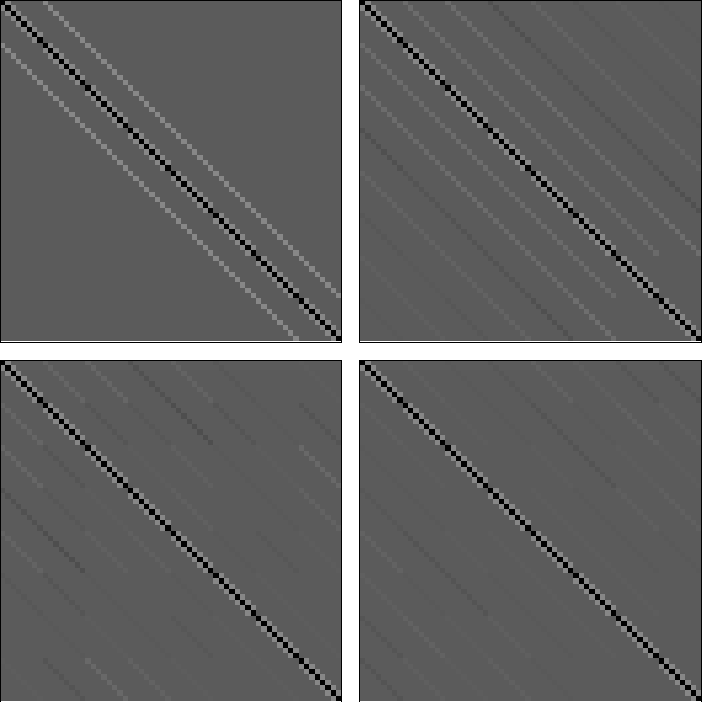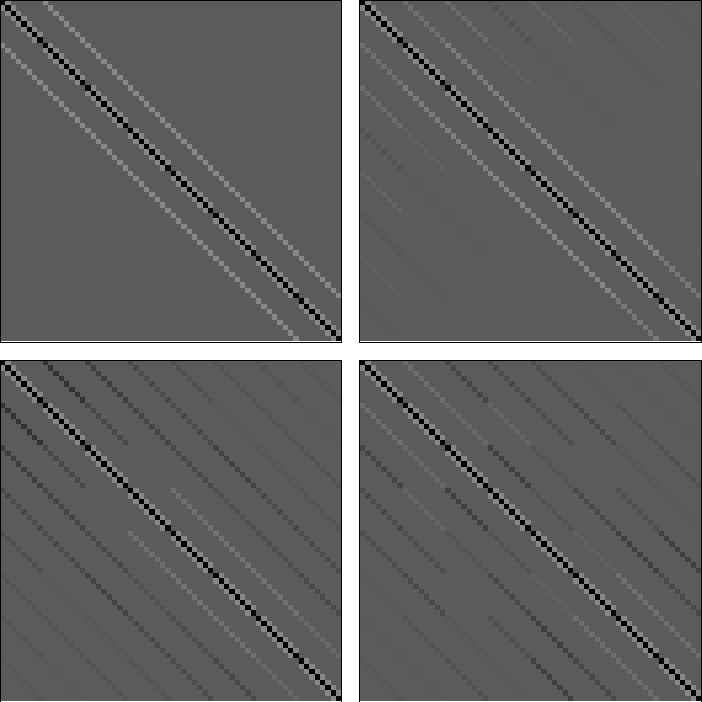 |
Figure 3 givenoise
![[*]](http://sepwww.stanford.edu/latex2html/cross_ref_motif.gif) shows the result after several
passes where there has been a random 4% variation in coefficient
amplitude introduced along the main diagonal and a 1% variation
along the other diagonals. The first pass of Givens rotations,
instead of introducing artifacts along a number of new diagonals,
introduces these artifacts over several fairly broad bands.
shows the result after several
passes where there has been a random 4% variation in coefficient
amplitude introduced along the main diagonal and a 1% variation
along the other diagonals. The first pass of Givens rotations,
instead of introducing artifacts along a number of new diagonals,
introduces these artifacts over several fairly broad bands.
This has serious consequences. Later passes spread these values out even further. After three passes, the matrix contains a large diagonal and a noisy background. At first glance, this might seem like a good result; the artifacts have dissipated rather than remaining as discrete events. The problem is that the number of operations needed to attenuate the artifacts becomes large very rapidly, so large that the cost of such an operation is prohibitive (order n2 rotations instead of order n for attacking a single diagonal).
 |
The problem in Figure ![[*]](http://sepwww.stanford.edu/latex2html/cross_ref_motif.gif) comes from the random
variation of the coefficient values. When we compute the
angle
comes from the random
variation of the coefficient values. When we compute the
angle ![]() for Givens rotation, we get slightly different
answers at each point because of the varying coefficients.
The angles that we compute are correct in that they do the best
possible job of attacking the off-diagonal elements. However,
the creation of artifacts is also controlled by the rotation
angles. Different angles mean that artifacts are created in
different places. Thus the 1% (4% on the main diagonal) variation
in coefficients introduces artifacts over ranges of positions
rather than at discrete locations. Again, this is a bad idea
because it means we have to do prohibitively many operations
to arrive at a tridiagonal form.
for Givens rotation, we get slightly different
answers at each point because of the varying coefficients.
The angles that we compute are correct in that they do the best
possible job of attacking the off-diagonal elements. However,
the creation of artifacts is also controlled by the rotation
angles. Different angles mean that artifacts are created in
different places. Thus the 1% (4% on the main diagonal) variation
in coefficients introduces artifacts over ranges of positions
rather than at discrete locations. Again, this is a bad idea
because it means we have to do prohibitively many operations
to arrive at a tridiagonal form.
One alternative is to use a constant (mean) value of rotation
angle to perform the Givens rotations. This constant angle
would keep artifacts confined to a few locations, and mean
that attenuating the artifacts with successive passes would be
much faster. In Figure ![[*]](http://sepwww.stanford.edu/latex2html/cross_ref_motif.gif) , I did this, using
a rotation angle computed from the mean values of the diagonal
coefficients. You can see that, as I predicted, the artifacts
remain along the diagonals, similar to Figure
, I did this, using
a rotation angle computed from the mean values of the diagonal
coefficients. You can see that, as I predicted, the artifacts
remain along the diagonals, similar to Figure ![[*]](http://sepwww.stanford.edu/latex2html/cross_ref_motif.gif) ,
rather than spreading over the entire matrix. This is good. On the
down side, however, successive passes of rotation do not
reduce the matrix to tridiagonal form. Compare the lower right
panel of Figure
,
rather than spreading over the entire matrix. This is good. On the
down side, however, successive passes of rotation do not
reduce the matrix to tridiagonal form. Compare the lower right
panel of Figure ![[*]](http://sepwww.stanford.edu/latex2html/cross_ref_motif.gif) to that of Figure
to that of Figure ![[*]](http://sepwww.stanford.edu/latex2html/cross_ref_motif.gif) ,
and you will see that the artifacts have not been attenuated
very well. More passes do not solve the problem.
,
and you will see that the artifacts have not been attenuated
very well. More passes do not solve the problem.
The reason this happens is because we used an average rotation angle. This angle does a relatively poor job of annihilating the off-diagonal elements, so no matter how many times we do it, these elements do not go away completely.
 |
All hope is not lost. Certainly in Figure ![[*]](http://sepwww.stanford.edu/latex2html/cross_ref_motif.gif) we have
improved the diagonal dominance of the matrix, at little cost.
We could use such an operator now in the Jacobi iterative scheme
or conjugate gradients and expect convergence to be much
faster. In the case of Jacobi, the 45 degree algorithm should
be stable where it was not before. So even if we have not been
able to reduce to tridiagonal form in the lateral velocity
case, this method should still be a useful preconditioner for
other methods.
we have
improved the diagonal dominance of the matrix, at little cost.
We could use such an operator now in the Jacobi iterative scheme
or conjugate gradients and expect convergence to be much
faster. In the case of Jacobi, the 45 degree algorithm should
be stable where it was not before. So even if we have not been
able to reduce to tridiagonal form in the lateral velocity
case, this method should still be a useful preconditioner for
other methods.